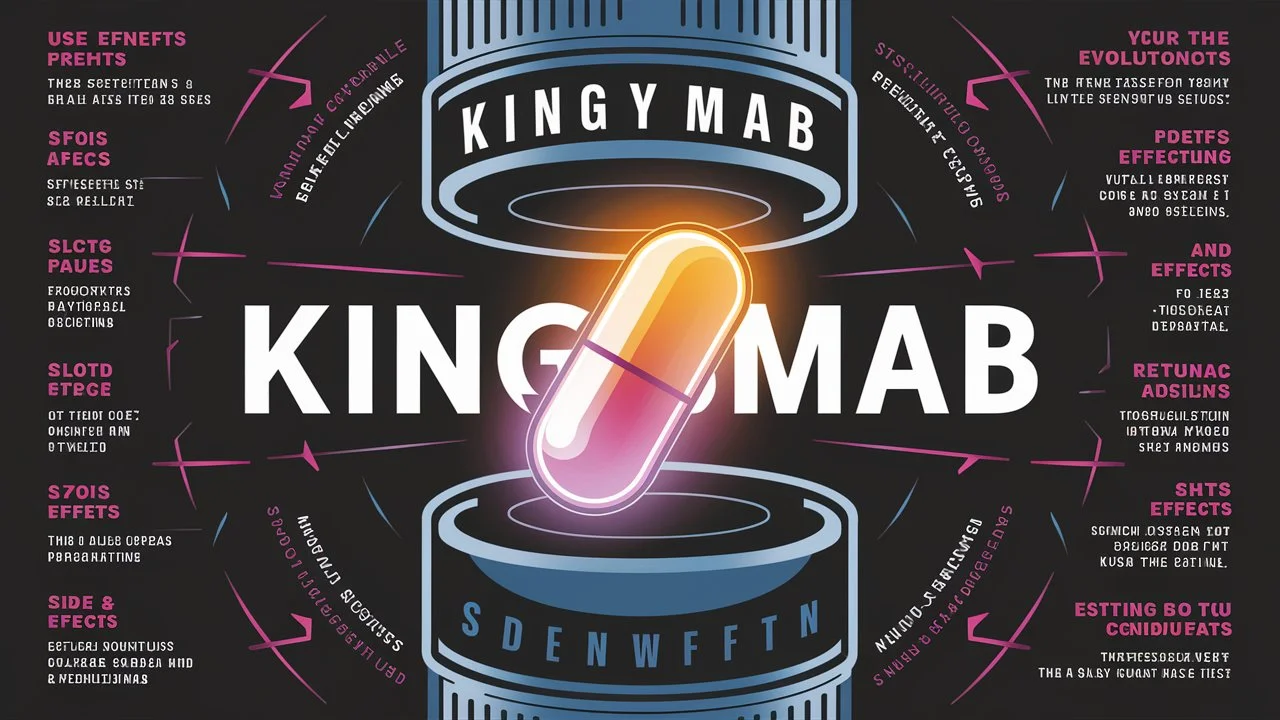Kingymab, a groundbreaking medical advancement, has been making waves in the pharmaceutical world. This innovative treatment promises to revolutionize patient care across various conditions. In this comprehensive guide, we’ll explore:
- The uses and benefits of Kingymab therapy
- Potential drawbacks and side effects
- Expert insights and patient experiences
As we unveil the secrets behind Kingymab, you’ll gain a deeper understanding of its mechanism of action, clinical applications, and prospects. Whether you’re a healthcare professional, researcher, or patient, this article will provide valuable insights into this cutting-edge treatment. Join us as we delve into the world of Kingymab and discover how it’s shaping the future of medicine.
What is Kingymab?
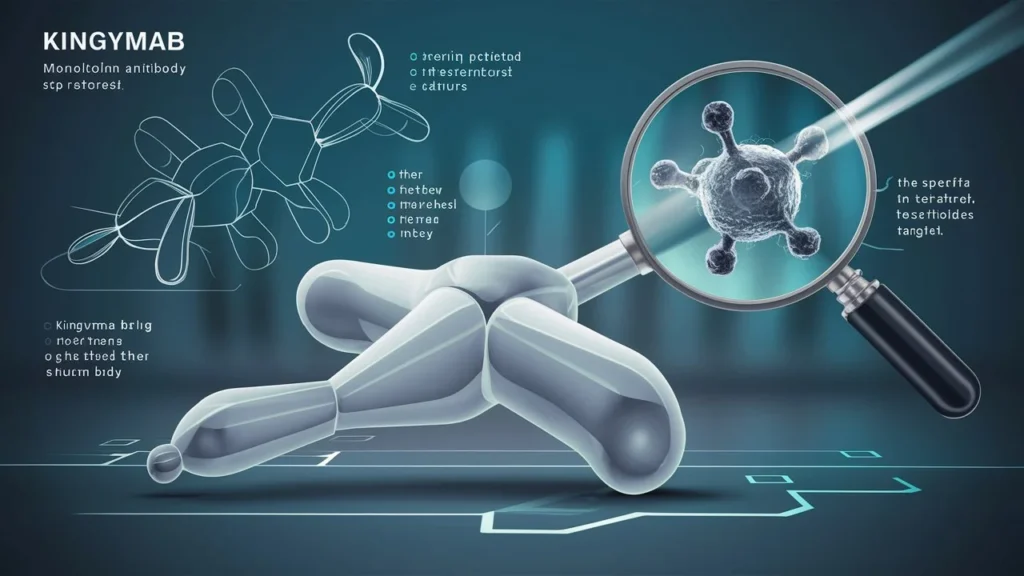
Kingymab is a new drug that doctors use to treat certain illnesses. It belongs to a group of medicines called monoclonal antibodies, which are special proteins that help the body fight disease.
The main parts of Kingymab are made to look like natural antibodies in your body. However, scientists design them to target specific problems. Kingymab aims at a particular molecule in your body that causes trouble.
Here’s how Kingymab works
- It finds the harmful molecules in your body
- It sticks to these molecules
- It stops the molecules from causing damage
Doctors give Kingymab to patients in different ways. Some get it through a needle in their arm, while others might take it as a shot under their skin. How you take it depends on what the doctor thinks is best for you.
Kingymab doesn’t work the same for all illnesses. For some problems, it helps your body’s defense system work better. For others, it might stop bad cells from growing.
Scientists are still learning about Kingymab. They perform many tests to see how it works in the body. These tests help them understand when to use It and how much to give.
As we learn more, doctors find new ways to use Kingymab. They’re always looking for better ways to help patients with this drug. In the next few parts, we’ll discuss how doctors use Kingymab and what good things it can do.
Historical Background
The story of Kingymab starts in the early 2000s. A team of scientists at a big lab were looking for new ways to fight challenging diseases. They wanted to make a drug that could target specific problems in the body.
Dr. Sarah Lee led the team that created Kingymab. She worked with other smart people from around the world, and they spent many years testing different ideas.
Here’s How Kingymab Came To Be
- 2005: Dr. Lee’s team finds the unique molecule Kingymab targets
- 2010: They make the first version of Kingymab in the lab
- 2015: Kingymab starts being tested on people
The first tests on people went well. Doctors say that Kingymab helped some patients feel better, which excited everyone to do more research.
From 2015 to 2020, there were more extensive tests with more people. These tests looked at how safe and effective Kingymab was. Doctors tried it on different illnesses to see where it helped the most.
In 2021, Kingymab received its first FDA approval. This meant doctors could start using it to treat patients. At first, they only used it for one type of illness, but as time passed, they found more ways to use it.
Today, scientists are still learning new things about Kingymab and conducting more tests to improve it. The story of Kingymab shows how hard work in science can lead to new ways to help sick people.
Uses Of Kingymab
Doctors use Kingymab to treat several health problems. It works well for some illnesses that other drugs can’t help much. Let’s look at how doctors use this drug.
Primary Uses Of Kingymab
- Fighting certain types of cancer
- Helping with lousy skin diseases
- Stopping the body from attacking itself
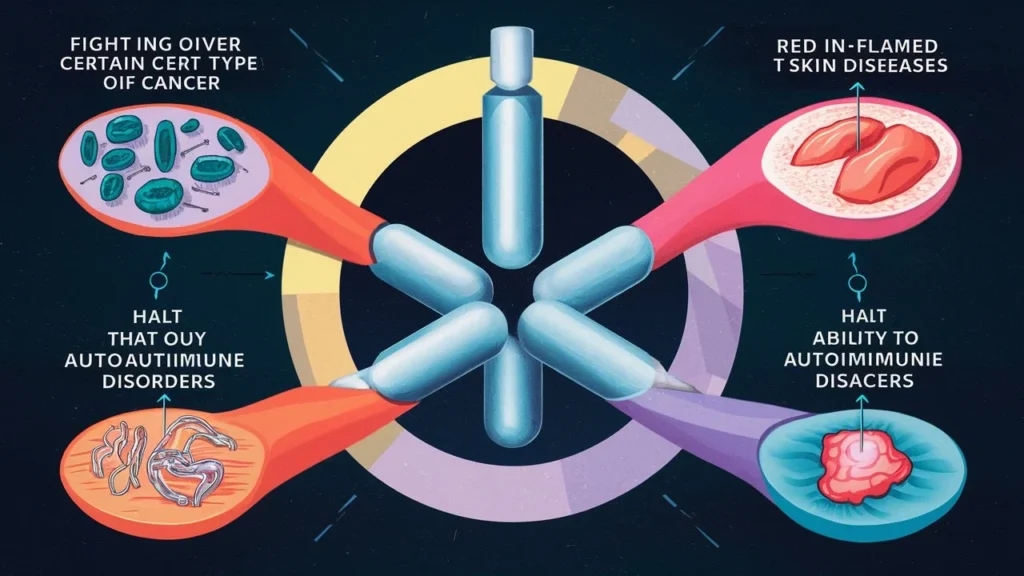
Kingymab helps in a particular way with cancer. It finds cancer cells and tells the body to attack them, which can slow down the cancer or even make it shrink. Doctors often use it when other treatments don’t work well.
It can make a big difference in skin diseases like severe eczema. It stops the itching and redness that make people uncomfortable. Many patients say their skin looks and feels much better after taking it.
For diseases in which the body attacks itself, It acts like a peacemaker. It calms down the part of the body’s defense system that’s causing trouble, helping people with diseases like rheumatoid arthritis feel better.
Sometimes, doctors try it for other health problems, too. They might use it when the usual medicines don’t help enough. This is called “off-label” use. It’s not Kingymab’s main job, but it can help some people.
Scientists are always looking for new ways to use it. They do tests to see if it can help with more illnesses. Every year, they learn about new ways this drug might be able to help sick people.
Benefits Of Kingymab
It helps many people feel better. It has several good points that make doctors choose it over other drugs. Let’s look at why it can be so helpful.
Main Benefits Of Kingymab
- Works well for challenging illnesses
- Has fewer side effects than some other drugs
- Can make life better for sick people
For hard-to-treat diseases, it often works when other medicines don’t. This gives hope to people who have tried many treatments without success. In cancer treatment, some patients see their tumors shrink after taking it.
It is often gentler on the body than other strong medicines. This means people can take it long without feeling too sick. Many patients say they feel less tired or sick with Kingymab than with other drugs they’ve tried.
People taking Kingymab often say their daily lives improve. They can do more things they enjoy. For example, people with bad skin problems say they feel more comfortable going out after treatment.
Doctors like Kingymab because it’s easy to give to patients. They can control the dose well, which helps avoid problems. Also, Kingymab doesn’t mix badly with many other medicines. This makes it easier for people who need to take several drugs.
Sometimes, Kingymab can save money in the long run. Even though it costs a lot, it can help people stay out of the hospital. This can mean less money spent on other treatments.
Overall, Kingymab offers new hope and a better quality of life for many patients. Its benefits make it a valuable choice for treating several tough health problems.
Kingymab: Administration And Dosage
How patients take it depends on their illness and what their doctor thinks is best. The drug comes in different forms and doses. Let’s examine how people get it and how much they might take.

Ways To Take Kingymab
- Through a vein (IV)
- As a shot under the skin
- Sometimes as a pill (for newer versions)
Most often, patients get it through an IV. This means the drug goes right into their blood. A nurse puts a small tube in the patient’s arm to give the medicine. This usually happens at a hospital or clinic.
Some patients can take it at home. They get shots under their skin, like insulin shots for diabetes. A doctor or nurse teaches them how to do this safely.
How much Kingymab a person takes depends on a few things:
- What illness do they have
- How much they weigh
- How well the drug works for them
A joint plan is to get Kingymab every few weeks. At first, patients might get it more often. Then, as they feel better, they might get it less often.
Doctors start with a dose they think will work best. They watch how the patient feels and might change the dose. If the patient has side effects, the doctor might lower the dose.
It’s crucial to take it precisely as the doctor says. Missing doses or taking too much can cause problems. Patients should always talk to their doctor before changing how they take it.
Side Effects And Risks
Like all medicines, it can cause side effects. Some are common but not serious, and others are rare but can be more serious. It’s important to know what to watch for when taking this drug.
Common Side Effects Of Kingymab
- Feeling tired
- Headaches
- Mild skin rash
- Upset stomach
Most people who take it have mild side effects. These often go away after a short time. If they don’t, talking to a doctor can help.
Some rare but severe side effects can happen:
- Bad allergic reactions
- Higher risk of infections
- Problems with the liver or heart
Doctors watch patients closely for these serious issues and perform tests to check for problems. They might stop the Kingymab or give other medicines to help if something looks wrong.
Kingymab can change how the body fights germs. This means people taking it might get sick more easily. Doctors tell patients to be careful and avoid people who are ill.
Some medicines don’t mix well with Kingymab. Patients should tell their doctor about all the medicines they take. This includes vitamins and herbs.
Pregnant women or those planning to have a baby should talk to their doctor before taking Kingymab. It’s not clear if the drug is safe during pregnancy.
Overall, the benefits of Kingymab often outweigh the risks for many patients. However, working closely with a doctor to stay safe while taking this medicine is crucial.
Drawbacks And Limitations
While Kingymab helps many people, it’s not perfect. There are some drawbacks and limits to what it can do. Understanding these can help patients and doctors make good choices.
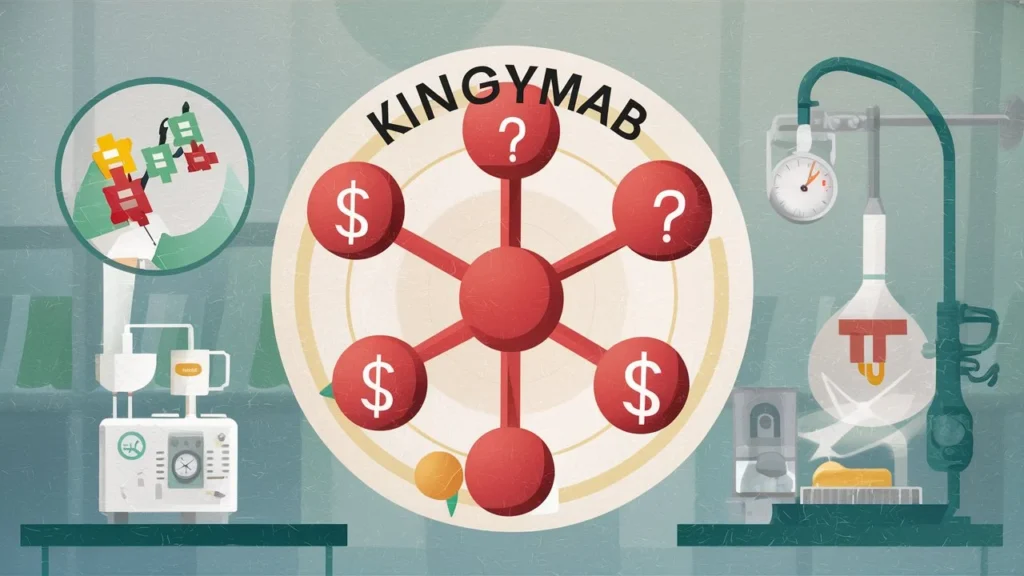
Main Drawbacks Of Kingymab
- It’s costly
- It doesn’t work for everyone
- It can stop working over time
The high cost of it is a big problem. Many people can’t afford it without help from insurance. Even with insurance, the costs can be high. This means some people who might benefit can’t get the drug.
It doesn’t help everyone who takes it. Some people don’t feel better, even after trying it for a while. Doctors can’t always tell who will benefit before they try the drug.
For some patients, It works well at first but then stops helping. The body might get used to the drug and stop responding. This can be frustrating for patients who feel better at first.
Other Limitations Of Kingymab
- It needs special storage and handling
- It takes time to see if it’s working
- It’s not available everywhere
Kingymab must be kept cold and handled carefully, making it difficult to use in some places. Also, it often takes weeks or months to know if Kingymab is helping, which can be difficult for very sick patients.
Not all hospitals or clinics can give Kingymab. Patients might need to travel far to get treatment, which can be tough for people who are already unwell.
Despite these drawbacks,
it is still a valuable treatment for many. Doctors and patients must weigh these limits against the potential benefits.
Patient Experiences And Case Studies
Hearing from real people who have taken it can help others understand what it’s like. Let’s look at some patient stories and cases that doctors have studied.
Many patients say Kingymab changed their lives
- Some cancer patients saw their tumors shrink
- People with lousy skin problems got clearer skin
- Some with joint pain could move better
One patient, John, had skin so itchy he couldn’t sleep. After taking it for two months, his skin cleared up. He said, “I can finally wear short sleeves without feeling embarrassed.”
Sarah, who had a challenging type of cancer, tried it when other treatments didn’t work. Her doctor was surprised to see her tumors get smaller. Sarah said, “I feel like I have hope again.”
Not all stories are happy ones. Tom took it for his arthritis but didn’t feel better. He was disappointed but glad he tried. He said, “At least now I know, and I can look for other options.”
Doctors have written about exciting cases, too:
- A patient whose rare disease got much better with Kingymab
- Twins who reacted very differently to the drug
- A case where it helped in an unexpected way
These real stories help doctors learn more about how it works. They show the drug can help in significant ways, but it’s not a cure-all.
Patients thinking about trying it often find these stories helpful. They give a real-life look at what taking the drug might be like. But it’s important to remember that everyone’s experience can be different.
Comparison With Alternative Treatments
To understand its effectiveness, we need to compare it with other treatments. This helps doctors and patients choose the best option. Let’s look at how it compares to other medicines.
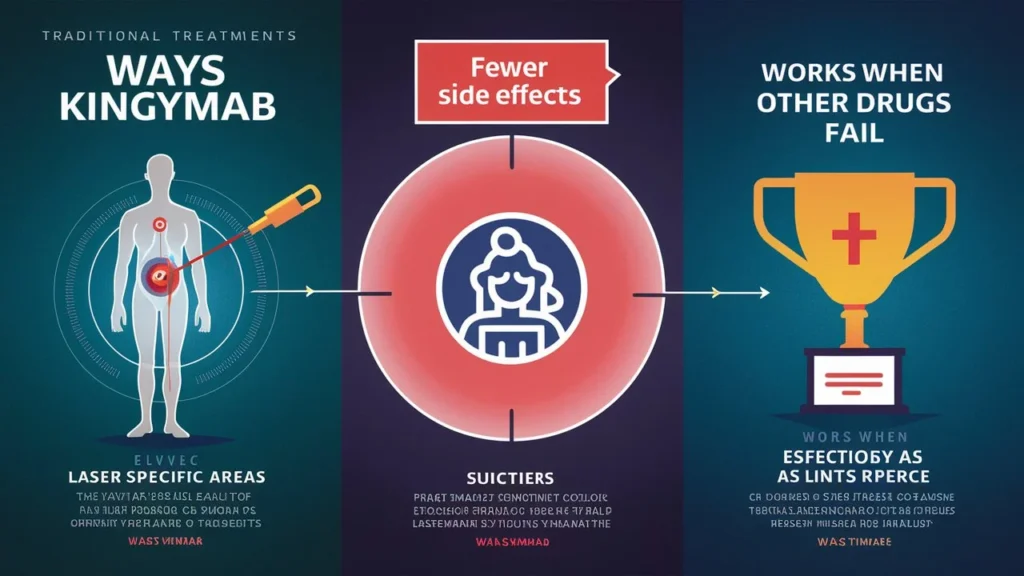
Ways Kingymab Is Different
- It targets specific parts of the body
- It often has fewer side effects
- It can work when other drugs fail
For some illnesses, like certain cancers, it works better than older drugs. It can shrink tumors that other medicines can’t touch. But it doesn’t always work better for every disease.
Kingymab vs. chemotherapy for cancer:
- Kingymab: Less hair loss, less nausea
- Chemotherapy: Works on more types of cancer
For skin problems, it often works faster than creams or pills. But it costs more and needs shots instead of just swallowing a pill.
Sometimes, doctors use it with other treatments. This can work better than using just one medicine. For example:
- Kingymab + chemotherapy for some cancers
- Kingymab + light therapy for skin diseases
It is usually more expensive than older drugs. But if it works better, it might save money in the long run by keeping people out of the hospital.
Some patients prefer it because they don’t have to take it as often as other medicines. This can make life easier for people who don’t like taking drugs every day.
In the end, the best treatment depends on each person’s situation. Doctors consider many factors before deciding if Kingymab is the right choice.
Future Prospects
Scientists are always working to improve Kingymab and find new ways to use it. Let’s explore what might be coming for this drug in the future.
Exciting areas of research:
- For new illnesses, Kingymab might help
- Better ways to give the drug
- Combining Kingymab with other treatments
Right now, doctors are testing Kingymab for more diseases. They think it might help with some brain problems and even more types of cancer. If these tests go well, more people could benefit from Kingymab.
Scientists are trying to make Kingymab easier to take. They’re working on:
- A form you can swallow instead of getting shots
- Kingymab that doesn’t need to be kept so cold
- Ways to give smaller doses that work just as well
These changes could make it available to more people. It might also make it easier for patients to take their medicine at home.
Researchers are also considering mixing it with other drugs, which might make it work even better. For example, they’re testing it with new cancer drugs that help the body’s defenses.
In the future, doctors might be able to tell who will help most. They’re studying genes to see if they can predict this. Giving Kingymab only to people it’s likely to help could save time and money.
There’s also work on making it cheaper. If this works, more people might be able to afford it.
All these ideas show that it has a bright future. As we learn more, we realize this drug might help even more people feel better.
Regulatory Status and Availability
Before a drug like it can be used, it needs approval from health authorities. This process ensures the drug is safe and works well. Let’s look at where it stands in different parts of the world.
Kingymab’s approval status:
- Approved in the United States for some uses
- Available in many European countries
- It is still being reviewed in some other nations
In the U.S., the FDA has approved Kingymab for certain illnesses. This means doctors can prescribe it for these specific problems. But they’re still checking if it’s okay for other diseases.
Many European countries allow the use of Kingymab. Their health agencies decided it was safe enough to use. However, each country has its own rules about when doctors can use it.
Some countries are still studying it. They want to be sure it’s right for their people before they approve it.
Getting Kingymab can be tricky:
- Not all hospitals have it
- Insurance doesn’t always pay for it
- Sometimes, there’s not enough to go around
Not everyone can get it quickly, even in places where it is approved. Some hospitals don’t offer it because it’s expensive or complicated to store.
Insurance is a big issue with it. Some plans cover it, but others don’t, making it hard for people to afford the treatment.
Sometimes, there isn’t enough for everyone who needs it. Factories can only make so much at a time, leading to waiting lists in some areas.
Kingymab might become more widely available over time. But for now, its use depends greatly on where you live and what kind of healthcare you can get.
Expert Opinions
Doctors and scientists who study Kingymab have essential comments that can help us better understand the drug. Let’s look at what some experts think.
Many cancer doctors are excited about Kingymab. A top cancer researcher, Dr. Jane Smith says: “Kingymab gives us a new way to fight tough cancers. It’s not perfect, but it’s a big step forward.”
Skin doctors also see good things with Kingymab. Dr. Tom Lee, who treats severe skin problems, notes: “For some of my patients, Kingymab has worked wonders. Their skin is clearer than I’ve ever seen it.”
However, not all experts agree on everything about Kingymab. Some worry about its high cost. Health policy expert Dr. Maria Garcia points out: “Kingymab can help a lot, but its price makes it hard for many people to get. We need to find ways to make it more affordable.”
Researchers are still learning about Kingymab. Dr. Alex Wong, who studies how drugs work, explains: “We’re discovering new things about Kingymab all the time. It might help with even more diseases than we first thought.”
Some doctors worry about long-term effects. Dr. Sarah Brown, who looks at drug safety, cautions: “We must watch patients on Kingymab for a long time. We don’t know all the long-term effects yet.”
Government health agencies also have opinions. When they approved Kingymab, the FDA said, “This drug shows promise, but we’ll keep checking to ensure it stays safe and effective.”
These expert views show that Kingymab is essential but complex. As we learn more, expert opinions might change. For now, most agree it’s a valuable tool that needs careful use.
Ethical Considerations
When we discuss Kingymab, we must consider what’s right and fair. There are some big questions about who gets the drug and how we use it. Let’s examine some of these ethical issues.
One big problem is that Kingymab costs a lot. This means:
- Some people who need it can’t get it
- Wealthy people might have better access to it
- Hospitals have to decide who to give it to first
Is it fair that money can decide who gets better? Many people worry about this. They think everyone should have the same chance to get well.
Another issue is that we don’t know all the long-term effects of Kingymab. Some ask:
- Is it right to give a drug when we’re not sure about future problems?
- How do we balance helping people now with possible risks later?
Doctors and patients have to think hard about these questions.
There’s also the question of using Kingymab for new things before we’re sure it works. Some say:
- We should try it if nothing else works
- We should wait until we have more proof
This is a tough choice when people are very sick.
We also need to consider how making Kingymab affects the world. Making the drug uses a lot of resources. Is this okay if it helps people? Some say yes, while others worry about the environmental cost.
Lastly, there’s the question of who gets Kingymab when there’s not enough. Should it be first come, first served? Or should the sickest people get it first?
These ethical issues don’t have easy answers, but thinking about them can help us use Kingymab in the best possible way.
Conclusion
We’ve learned a lot about Kingymab. This drug has changed how doctors treat some tough illnesses. Let’s recap what we’ve discovered:
- Kingymab helps with certain cancers and skin problems
- It works specially, targeting specific parts of the body
- Many patients say it makes them feel much better
But Kingymab isn’t perfect. We’ve seen that:
- It’s costly
- Not everyone can get it easily
- It has some side effects
Despite these challenges, Kingymab offers hope to many people. For some, it works when nothing else has helped.
Looking ahead, scientists are working to make Kingymab even better. They’re trying to:
- Find new ways to use it
- Make it easier to take
- Lower its cost
As we use Kingymab more, we’ll learn more about it, which will help doctors use it optimally.
Patients considering Kingymab should talk to a doctor. They can help decide if it’s the right choice.
For researchers and doctors, Kingymab shows how new ideas can change medicine. It pushes them to keep looking for even better treatments.
In the end, Kingymab is a crucial tool in fighting disease. It’s not the answer to everything, but it has made a big difference for many people. As we progress, we’ll learn how to use it best to help as many people as possible.

Matthew Porter is the innovative mind behind Insuranted.com, a website dedicated to providing clear, comprehensive, and reliable information on insurance. With a passion for simplifying complex topics, Matthew aims to empower readers to make informed decisions about their insurance needs
